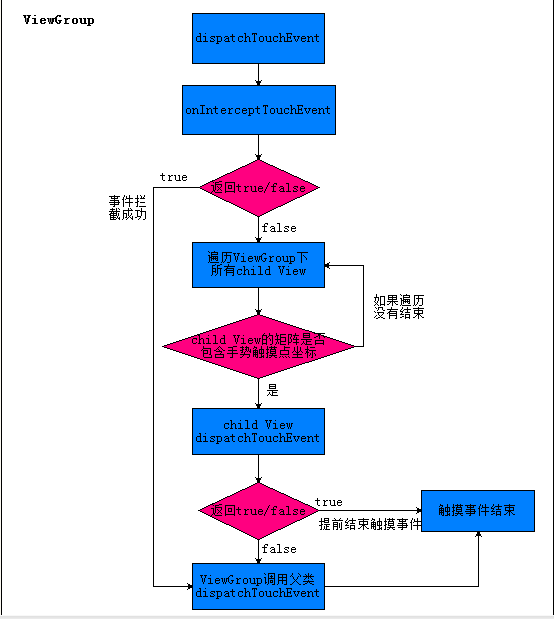Android ViewGroup 触摸事件传递机制
引言
上一篇博客我们学习了Android View 触摸事件传递机制,不了解的同学可以查看Android View 触摸事件传递机制。今天继续学习Android触摸事件传递机制,这篇博客将和大家一起探讨ViewGroup的触摸事件传递机制。
示例
示例代码如下:
public class MainActivity extends ActionBarActivity {
private String TAG = "MainActivity";
private MyViewGroup parentView;
private Button childView;
@Override
protected void onCreate(Bundle savedInstanceState) {
super.onCreate(savedInstanceState);
setContentView(R.layout.activity_main);
parentView = (MyViewGroup) findViewById(R.id.parent);
childView = (Button) findViewById(R.id.child);
childView.setOnClickListener(new View.OnClickListener() {
@Override
public void onClick(View v) {
Log.e(TAG, "childView=====onClick");
}
});
parentView.setOnTouchListener(new View.OnTouchListener() {
@Override
public boolean onTouch(View v, MotionEvent event) {
Log.e(TAG, "parentView=====onTouch");
return false;
}
});
parentView.setOnClickListener(new View.OnClickListener() {
@Override
public void onClick(View v) {
Log.e(TAG, "parentView=====onClick");
}
});
}
}自定义MyViewGroup,并且重写dispatchTouchEvent方法添加打印日志,重写onInterceptTouchEvent方法添加打印日志:
public class MyViewGroup extends LinearLayout {
private String TAG = "MyViewGroup";
public MyViewGroup(Context context) {
super(context);
}
public MyViewGroup(Context context, AttributeSet attrs) {
super(context, attrs);
}
public MyViewGroup(Context context, AttributeSet attrs, int defStyleAttr) {
super(context, attrs, defStyleAttr);
}
@Override
public boolean dispatchTouchEvent(MotionEvent ev) {
Log.e(TAG, "MyViewGroup=====dispatchTouchEvent "+ev.getAction());
return super.dispatchTouchEvent(ev);
}
@Override
public boolean onInterceptTouchEvent(MotionEvent ev) {
Log.e(TAG, "MyViewGroup=====onInterceptTouchEvent");
return super.onInterceptTouchEvent(ev);
}
}布局如下:
<com.xjp.viewgrouptouchdemo.MyViewGroup xmlns:android="http://schemas.android.com/apk/res/android"
xmlns:tools="http://schemas.android.com/tools"
android:id="@+id/parent"
android:layout_width="match_parent"
android:layout_height="match_parent"
android:paddingBottom="@dimen/activity_vertical_margin"
android:paddingLeft="@dimen/activity_horizontal_margin"
android:paddingRight="@dimen/activity_horizontal_margin"
android:paddingTop="@dimen/activity_vertical_margin"
tools:context=".MainActivity">
分别点击Button按钮和空白区域,打印结果如下:
08-01 17:02:56.792 14706-14706/com.xjp.viewgrouptouchdemo E/MyViewGroup﹕ MyViewGroup=====dispatchTouchEvent
08-01 17:02:56.792 14706-14706/com.xjp.viewgrouptouchdemo E/MainActivity﹕ childView=====onClick08-01 17:03:31.046 14706-14706/com.xjp.viewgrouptouchdemo E/MyViewGroup﹕ MyViewGroup=====dispatchTouchEvent
08-01 17:03:31.046 14706-14706/com.xjp.viewgrouptouchdemo E/MainActivity﹕ parentView=====onTouch1
08-01 17:03:31.046 14706-14706/com.xjp.viewgrouptouchdemo E/MainActivity﹕ parentView=====onClick从上面打印可以看出,在ViewGroup嵌套Button布局中,仅仅点击Button按钮时只会执行Button的触摸事件,不会执行ViewGroup的触摸事件。当你点击Button以外的空白区域时,才会执行ViewGroup的触摸事件。那为什么在ViewGroup嵌套View时只会执行View的触摸事件而不执行ViewGroup的触摸事件呢?待着这个疑问,我们来分析下ViewGroup源码中的dispatchTouchEvent方法。为了方便起见,我这里都是分析的Android2.0的源码。
ViewGroup#dispatchTouchEvent
@Override
public boolean dispatchTouchEvent(MotionEvent ev) {
final int action = ev.getAction();
final float xf = ev.getX();
final float yf = ev.getY();
final float scrolledXFloat = xf + mScrollX;
final float scrolledYFloat = yf + mScrollY;
final Rect frame = mTempRect;
boolean disallowIntercept = (mGroupFlags & FLAG_DISALLOW_INTERCEPT) != 0;
if (action == MotionEvent.ACTION_DOWN) {
if (mMotionTarget != null) {
// this is weird, we got a pen down, but we thought it was
// already down!
// XXX: We should probably send an ACTION_UP to the current
// target.
mMotionTarget = null;
}
// If we're disallowing intercept or if we're allowing and we didn't
// intercept
if (disallowIntercept || !onInterceptTouchEvent(ev)) {
// reset this event's action (just to protect ourselves)
ev.setAction(MotionEvent.ACTION_DOWN);
// We know we want to dispatch the event down, find a child
// who can handle it, start with the front-most child.
final int scrolledXInt = (int) scrolledXFloat;
final int scrolledYInt = (int) scrolledYFloat;
final View[] children = mChildren;
final int count = mChildrenCount;
for (int i = count - 1; i >= 0; i--) {
final View child = children[i];
if ((child.mViewFlags & VISIBILITY_MASK) == VISIBLE
|| child.getAnimation() != null) {
child.getHitRect(frame);
if (frame.contains(scrolledXInt, scrolledYInt)) {
// offset the event to the view's coordinate system
final float xc = scrolledXFloat - child.mLeft;
final float yc = scrolledYFloat - child.mTop;
ev.setLocation(xc, yc);
if (child.dispatchTouchEvent(ev)) {
// Event handled, we have a target now.
mMotionTarget = child;
return true;
}
// The event didn't get handled, try the next view.
// Don't reset the event's location, it's not
// necessary here.
}
}
}
}
}
boolean isUpOrCancel = (action == MotionEvent.ACTION_UP) ||
(action == MotionEvent.ACTION_CANCEL);
if (isUpOrCancel) {
// Note, we've already copied the previous state to our local
// variable, so this takes effect on the next event
mGroupFlags &= ~FLAG_DISALLOW_INTERCEPT;
}
// The event wasn't an ACTION_DOWN, dispatch it to our target if
// we have one.
final View target = mMotionTarget;
if (target == null) {
// We don't have a target, this means we're handling the
// event as a regular view.
ev.setLocation(xf, yf);
return super.dispatchTouchEvent(ev);
}
// if have a target, see if we're allowed to and want to intercept its
// events
if (!disallowIntercept && onInterceptTouchEvent(ev)) {
final float xc = scrolledXFloat - (float) target.mLeft;
final float yc = scrolledYFloat - (float) target.mTop;
ev.setAction(MotionEvent.ACTION_CANCEL);
ev.setLocation(xc, yc);
if (!target.dispatchTouchEvent(ev)) {
// target didn't handle ACTION_CANCEL. not much we can do
// but they should have.
}
// clear the target
mMotionTarget = null;
// Don't dispatch this event to our own view, because we already
// saw it when intercepting; we just want to give the following
// event to the normal onTouchEvent().
return true;
}
if (isUpOrCancel) {
mMotionTarget = null;
}
// finally offset the event to the target's coordinate system and
// dispatch the event.
final float xc = scrolledXFloat - (float) target.mLeft;
final float yc = scrolledYFloat - (float) target.mTop;
ev.setLocation(xc, yc);
return target.dispatchTouchEvent(ev);
}分析:
1. 代码3-8行,获取当前手指在屏幕上触摸点击的坐标位置,用于判断当前手指触摸点击的是View区域还是ViewGroup区域。
2. 代码第10行,获得disallowIntercept的值,disallowIntercept指的是是否禁用掉事件拦截功能,默认值是false,你可以调用requestDisallowInterceptTouchEvent方法修改它。
3. 代码第12行,手指触摸手势是先ACTION_DOWN操作,所以条件满足,进入if条件。
4. 代码第13-19行,清除当前手机屏幕上触摸点击对象,也就是将mMotionTarget设置为null。意思是在点击手机屏幕之前是没有任何触摸点击对象的。
5. 代码第22行,由于disallowIntercept默认值是false,所以条件是否满足完全取决于方法onInterceptTouchEvent返回值取反。而我们进入该方法会发现里面的实现仅仅是返回一个false。也就是if条件满足。
6. 代码第31行,通过一个for循环遍历当前ViewGroup下所以子View。
7. 代码第35行,获取遍历子View在屏幕上的坐标位置,然后代码第36行,判断当前屏幕手指触摸点击坐标是否包含遍历的子View在屏幕上的坐标位置范围?如果包含,者表示当前手指触摸点击的地方是该子View,也就是点击了Button。否则表示当前手指触摸并没有点击到ViewGroup中的子View,也就是点击到了空白区域。
8. 代码第41行,调用子View的dispatchTouchEvent方法来处理View的触摸事件分发,这里一步就是我们上一篇博客分析的 Android View 触摸事件传递机制入口。在这篇博客中我们知道,当View是可点击的或者长安点击或者设置了setOnClickListener点击监听事件的,View#dispatchTouchEvent方法一律返回true,否则返回false。所以当条件满足,也就是子View设置了点击事件时ViewGroup#dispatchTouchEvent方法返回true,触摸对象mMotionTarget = child赋值成当前点击的子Viwe执行结束。因此这也验证了上面示例代码,当button设置了点击事件时只执行了Button的onClick事件,并没有执行任何关于ViewGroup的触摸点击事件。
9. 代码第66-72行,假如上面的View#dispatchTouchEvent方法返回false,表示子View不可点击(可以参考上一篇博客),此时mMotionTarget依然为null,那么target==null条件满足。执行父类的dispatchTouchEvnet方法,也就是View的dispatchTouchEvent方法。由于ViewGroup的父类是View,所以此处表示执行了ViewGroup的dispatchTouchEvent方法。言外之意就是,当ViewGroup嵌套的子View不可点击且没有设置setOnClickListener点击监听事件时,点击View先触发子View的触摸事件,然后在触发ViewGroup的触摸事件,执行了ViewGroup#dispatchTouchEvent方法,并且返回了,后面代码不执行。
10. 代码第76-103行,主要是执行子View的ACTION_UP和ACTION_CANCEL手势操作的,逻辑这里就不具体分析了,可以参考上一篇博客。
总结:有上面分析我们知道。
- onInterceptTouchEvent方法是用于ViewGroup对子View的触摸事件拦截功能,默认返回false,不拦截子View的触摸事件,可以重写该方法,返回true来拦截子View的触摸事件传递。此时只会执行ViewGroup的触摸事件传递。
- 当子View是不可点击的且没有设置setOnClickListener点击监听事件时,会先执行子View的触摸事件,然后在执行ViewGroup的触摸事件。
现在俩验证以上两个结论。
onInterceptTouchEvent返回true
修改MyViewGroup代码
public class MyViewGroup extends LinearLayout {
private String TAG = "MyViewGroup";
public MyViewGroup(Context context) {
super(context);
requestDisallowInterceptTouchEvent(false);
}
public MyViewGroup(Context context, AttributeSet attrs) {
super(context, attrs);
}
public MyViewGroup(Context context, AttributeSet attrs, int defStyleAttr) {
super(context, attrs, defStyleAttr);
}
@Override
public boolean dispatchTouchEvent(MotionEvent ev) {
Log.e(TAG, "MyViewGroup=====dispatchTouchEvent ");
return super.dispatchTouchEvent(ev);
}
@Override
public boolean onInterceptTouchEvent(MotionEvent ev) {
return true;
}点击Button按钮,打印结果如下:
08-01 18:36:56.815 29910-29910/com.xjp.viewgrouptouchdemo E/MyViewGroup﹕ MyViewGroup=====dispatchTouchEvent
08-01 18:36:56.825 29910-29910/com.xjp.viewgrouptouchdemo E/MainActivity﹕ parentView=====onTouch1
08-01 18:36:56.825 29910-29910/com.xjp.viewgrouptouchdemo E/MainActivity﹕ parentView=====onClick有打印可以看出,当重写onInterceptTouchEvent方法返回true时,是不会执行Button的触摸点击事件的。也正好验证了前面的结论:当ViewGroup重写onInterceptTouchEvent方法返回true时,也就是拦截子View的触摸事件传递,此时只会执行ViewGroup的触摸事件。
子View不可点击且没设置setOnClickListener
代码修改如下:
public class MainActivity extends ActionBarActivity {
private String TAG = "MainActivity";
private MyViewGroup parentView;
private ImageView childView;
@Override
protected void onCreate(Bundle savedInstanceState) {
super.onCreate(savedInstanceState);
setContentView(R.layout.activity_main);
parentView = (MyViewGroup) findViewById(R.id.parent);
childView = (ImageView) findViewById(R.id.child);
childView.setOnTouchListener(new View.OnTouchListener() {
@Override
public boolean onTouch(View v, MotionEvent event) {
Log.e(TAG, "childView=====onTouch");
return false;
}
});
parentView.setOnTouchListener(new View.OnTouchListener() {
@Override
public boolean onTouch(View v, MotionEvent event) {
Log.e(TAG, "parentView=====onTouch" +event.getAction());
return false;
}
});
parentView.setOnClickListener(new View.OnClickListener() {
@Override
public void onClick(View v) {
Log.e(TAG, "parentView=====onClick");
}
});
}
}将Button换成ImageView,并且不设置setOnClickListener事件。点击ImageView打印日志如下:
08-01 18:52:44.720 31219-31219/com.xjp.viewgrouptouchdemo E/MyViewGroup﹕ MyViewGroup=====dispatchTouchEvent
08-01 18:52:44.720 31219-31219/com.xjp.viewgrouptouchdemo E/MainActivity﹕ childView=====onTouch
08-01 18:52:44.730 31219-31219/com.xjp.viewgrouptouchdemo E/MainActivity﹕ parentView=====onTouch0
parentView=====onClick
有打印可以看出,即执行了子View ImageView的触摸事件,也执行了ViewGroup的触摸事件。由于ImageView默认情况是不可点击的,因此:当子View不可点击或者么有设置setOnClickListener点击事件时,点击子View是先执行View的触摸事件,然后在执行ViewGroup的触摸事件的。这也验证了ViewGroup#dispatchTouchEvent小节的第9点。
最后附带上一幅ViewGroup触摸事件传递流程图
总结
- 可以在ViewGroup里重写onInterceptTouchEvent方法来决定是否拦截子View的传递事件,系统默认返回false,表示不拦截子View的事件分发传递;如果重写返回true,表示拦截子View的触摸事件。
- 当子View是可点击的或者设置了setOnClickListener点击事件时,android触摸事件分发是不会传递到ViweGroup的,也就是只会执行View的触摸事件,不会执行ViewGroup的触摸事件。
- 当子View不可点击且没有设置setOnClickListener点击事件时,Android触摸事件是先分发到View,View先执行dispatchTouchEvent触摸事件,然后在传递到ViewGroup,ViewGroup执行dispatchTouchEvent触摸事件。
- Android事件分发先传递到View,在由View决定是否传递到ViewGroup。
